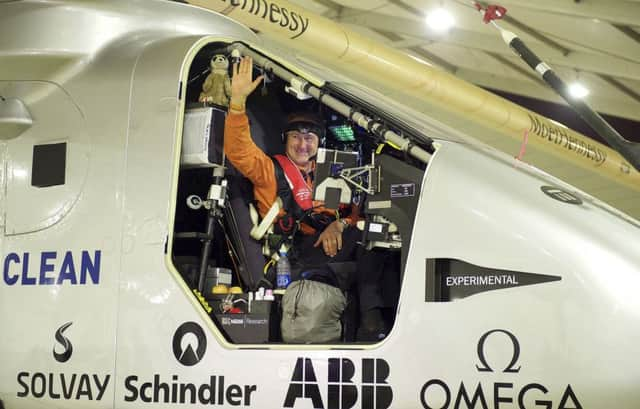Solar flight around the world to take break in Japan


Swiss pilot André Borschberg took off from Nanjing, China, on Sunday on what was to be the longest leg of the journey, a six-day, 5,079-mile flight to Hawaii.
Instead, the Solar Impulse 2 will land in Nagoya in central Japan, organisers said. Japanese Transport Ministry and Nagoya airport officials confirmed yesterday that they were making arrangements for an unanticipated landing at Nagoya Airport.
Advertisement
Hide AdAdvertisement
Hide AdElke Neumann, a spokeswoman for the Solar Impulse project, said from Nanjing that the team first noticed the bad weather pattern about 36 hours ago.
“We thought we might go through it,” she said. “But between Japan and Hawaii there’s no place to stop.”
The safety of the pilot and the plane are the priority, and the team will likely wait a few days in Japan until the weather changes, she said. The plane was due to land after scheduled flights at the airport ended last night.
Solar Impulse 2 needs room to land, so it generally avoids times when commercial flights are operating, Ms Neuman said. The plane also usually lands at night, because the winds tend to be lower. It needs wind to be no more than ten knots.
“We are a little bit sad, because everything’s functioning perfectly: The batteries are charging, there’s enough sun, the pilot is in good health, he’s in good condition – it’s all working well,” Ms Neumann said. The journey started in March in Abu Dhabi, and the plane has stopped in Oman, India, Myanmar and China. The flight from Nanjing to Hawaii is the seventh of 12 flights, and the riskiest.
The solar-powered airplane made its maiden flight in Switzerland in June last year.
The single-seater aircraft is made of carbon fibre, and the cockpit has a total area of 40.9 square feet.
It has no fuel on board and at 382 stone, weighs around the same as a car. With a wingspan of 236ft, it is larger than a Boeing 747-8I jet liner.
Advertisement
Hide AdAdvertisement
Hide AdThe 17,000 solar cells built into the wings supply four electric motors (17.5 CV each) with renewable energy.
During the day, the solar cells recharge lithium batteries weighing 2,077lbs, allowing the aircraft to fly day and night.
The team had waited for optimal conditions to make the flight, to make sure the chance of success was as high as possible.
But spotting a problem so early on was important – had the plane gone much further, with the conditions worsening, Mr Borschberg would have had to bail out, using a parachute to land before inflating a life raft and awaiting rescue.
The plane, in this scenario, would be left to crash into the ocean by itself, because if the pilot went down with the plane, he would risk being electrocuted in the water.
“If you manage to get in the life raft, then you are pretty fine,” he said.
“You can spend two days waiting for a ship to pass by, and an aircraft can drop you a larger life raft so that you are a little more comfortable.”
Speaking before the latest flight, he said: “What we are always looking for is a weak spot [in the weather].
Advertisement
Hide AdAdvertisement
Hide Ad“You work 12 years for this, so you don’t want to jeopardise everything you did by making a stupid decision.”
The danger arises because the plane is very fragile: it is as wide as a passenger jet but as light as a car.